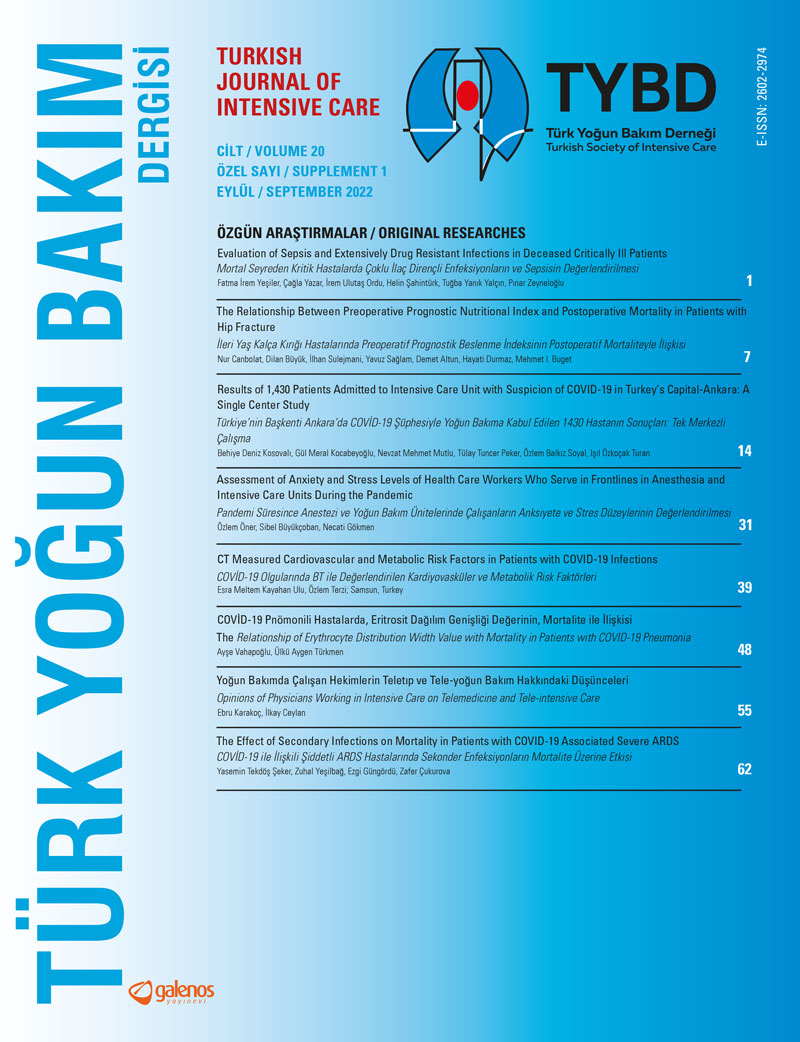Abstract
Objective:
Sepsis due to the drug resistant infections is associated with the higher mortality rates in an intensive care unit (ICU). The aim of this study was to determine the demographic characteristics of the deceased critically ill patients, prevalence of the sepsis, and extensively drug resistant infectious-related (XDR) deaths within a year in the ICU.
Materials and Methods:
The data of patients who died in the ICU between January 1, 2019 and 2020 was retrospectively analyzed.
Results:
Out of 525 patients admitted to the ICU, 269 of them died. One hundred fifty-one of those deceased patients (56.1%) were in medical and 118 (43.9%) in the surgical ICU. Their mean age was 70.5±15 years and 126 (46.8%) of them were female. The mean Acute Physiology and Chronic Health Evaluation-II, Glasgow coma score, Sequential Organ Failure Assessment scores at ICU admission were 23.4±20.9, 9.8±4.4, and 8.2±3.6, respectively. A few reasons for the ICU admission were: respiratory failure (34.9%), neurologic dysfunction (19%), sepsis (17.8%), and cardiovascular failure (16%). Infection occurred in the 231 (85.9%) patients. Of the 109 (40.5%) deceased patients with the diagnosis of sepsis, 48 (40%) of them were admitted in the ICU with sepsis. The most common site of infection was the respiratory system (34.6%). Septic shock was seen in 170 patients (63.2%) and renal replacement therapy was needed in 61 (22.7%) of them. XDR developed in 34.6% of the deceased patients and was more frequent among those with an antibiotic usage before the ICU admission (p=0.02). The mean length of stay at hospital before the ICU admission and length of the ICU stay were 22±25.8 and 10.1±12.7 days, respectively. The number of the deceased medical patients were significantly higher than the surgical patients (p=0.018).
Conclusion:
The deceased critically ill medical patients were higher than the surgical patients. A total of 40% of the deceased critically ill patients were diagnosed with a sepsis, and one third of them had XDR infection. XDR infections were more frequent among the patients with an antibiotic usage before the ICU admission.
Keywords: Extensively drug-resistant, sepsis, deceased critically ill patient, intensive care unit
References
- Singer M, Deutschman CS, Seymour CW, Shankar-Hari M, Annane D, Bauer M, et al. The Third International Consensus Definitions for Sepsis and Septic Shock (Sepsis-3). JAMA 2016;315:801-10.
- Cecconi M, Evans L, Levy M, Rhodes A. Sepsis and septic shock. Lancet 2018;392:75-87.
- Fleischmann C, Scherag A, Adhikari NK, Hartog CS, Tsaganos T, Schlattmann P, et al. Assessment of Global Incidence and Mortality of Hospital-treated Sepsis. Current Estimates and Limitations. Am J Respir Crit Care Med 2016;193:259-72.
- Rudd KE, Johnson SC, Agesa KM, Shackelford KA, Tsoi D, Kievlan DR, et al. Global, regional, and national sepsis incidence and mortality, 1990-2017: analysis for the Global Burden of Disease Study. Lancet 2020;395:200-11.
- Magiorakos AP, Srinivasan A, Carey RB, Carmeli Y, Falagas ME, Giske CG, et al. Multidrug-resistant, extensively drug-resistant and pandrug-resistant bacteria: an international expert proposal for interim standard definitions for acquired resistance. Clin Microbiol Infect 2012;18:268-81.
- Alexopoulou A, Vasilieva L, Agiasotelli D, Siranidi K, Pouriki S, Tsiriga A, et al. Extensively drug-resistant bacteria are an independent predictive factor of mortality in 130 patients with spontaneous bacterial peritonitis or spontaneous bacteremia. World J Gastroenterol 2016;22:4049-56.
- Shi J, Sun T, Cui Y, Wang C, Wang F, Zhou Y, et al. Multidrug resistant and extensively drug resistant Acinetobacter baumannii hospital infection associated with high mortality: a retrospective study in the pediatric intensive care unit. BMC Infect Dis 2020;20:597.
- Palavutitotai N, Jitmuang A, Tongsai S, Kiratisin P, Angkasekwinai N. Epidemiology and risk factors of extensively drug-resistant Pseudomonas aeruginosa infections. PLoS One 2018;13:e0193431.
- Kidney disease: improving global outcomes (KDIGO) acute kidney injury work group. KDIGO clinical practice guideline for acute kidney injury. March 2012. https://kdigo.org/wp-content/uploads/2016/10/KDIGO-2012-AKI-GuidelineEnglish. pdf.
- Orban JC, Walrave Y, Mongardon N, Allaouchiche B, Argaud L, Aubrun F, et al. Causes and Characteristics of Death in Intensive Care Units: A Prospective Multicenter Study. Anesthesiology 2017;126:882-9.
- Ay E, Weigand MA, Röhrig R, Gruss M. Dying in the Intensive Care Unit (ICU): A Retrospective Descriptive Analysis of Deaths in the ICU in a Communal Tertiary Hospital in Germany. Anesthesiol Res Pract 2020;2020:2356019.
- Mayr VD, Dünser MW, Greil V, Jochberger S, Luckner G, Ulmer H, et al. Causes of death and determinants of outcome in critically ill patients. Crit Care 2006;10:R154.
- Trecarichi EM, Pagano L, Candoni A, Pastore D, Cattaneo C, Fanci R, et al. Current epidemiology and antimicrobial resistance data for bacterial bloodstream infections in patients with hematologic malignancies: an Italian multicentre prospective survey. Clin Microbiol Infect 2015;21:337-43.
- Basak S, Singh P, Rajurkar M. Multidrug Resistant and Extensively Drug Resistant Bacteria: A Study. J Pathog 2016;2016:4065603.
Copyright and license
Copyright © 2022 The Author(s). This is an open access article distributed under the Creative Commons Attribution License (CC BY), which permits unrestricted use, distribution, and reproduction in any medium or format, provided the original work is properly cited.






















